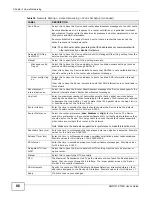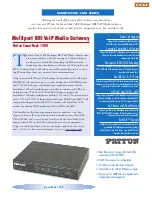
Chapter 6 Wireless
AMG1312-T10D User’s Guide
71
The types of encryption you can choose depend on the type of authentication. (See
for information about this.)
For example, if the wireless network has a RADIUS server, you choose
WPA2
. If users do not log in
to the wireless network, you can choose no encryption,
Static WEP
or
WPA2-PSK
.
Usually, you should set up the strongest encryption that every device in the wireless network
supports. For example, suppose you have a wireless network with the Device and you do not have
a RADIUS server. Therefore, there is no authentication. Suppose the wireless network has two
devices. Device A only supports WEP, and device B supports WEP and WPA2. Therefore, you should
set up
Static WEP
in the wireless network.
Note: It is recommended that wireless networks use
WPA2-PSK
or
WPA2
encryption.
The other types of encryption are better than none at all, but it is still possible for
unauthorized wireless devices to figure out the original information pretty quickly.
When you select
WPA2
or
WPA2-PSK
in your Device, you can also select an option (
WPA
compatible
) to support WPA as well. In this case, if some of the devices support WPA and some
support WPA2, you should set up
WPA2-PSK
or
WPA2
(depending on the type of wireless network
login) and select the
WPA compatible
option in the Device.
Many types of encryption use a key to protect the information in the wireless network. The longer
the key, the stronger the encryption. Every device in the wireless network must have the same key.
6.10.3 Signal Problems
Because wireless networks are radio networks, their signals are subject to limitations of distance,
interference and absorption.
Problems with distance occur when the two radios are too far apart. Problems with interference
occur when other radio waves interrupt the data signal. Interference may come from other radio
transmissions, such as military or air traffic control communications, or from machines that are
coincidental emitters such as electric motors or microwaves. Problems with absorption occur when
physical objects (such as thick walls) are between the two radios, muffling the signal.
6.10.4 BSS
A Basic Service Set (BSS) exists when all communications between wireless stations or between a
wireless station and a wired network client go through one access point (AP).
Intra-BSS traffic is traffic between wireless stations in the BSS. When Intra-BSS traffic blocking is
disabled, wireless station A and B can access the wired network and communicate with each other.
Table 24
Types of Encryption for Each Type of Authentication
NO AUTHENTICATION
RADIUS SERVER
Weakest
No Security
WPA
Static WEP
WPA-PSK
Strongest
WPA2-PSK
WPA2
Summary of Contents for AMG1312-T10D
Page 4: ...Contents Overview AMG1312 T10D User s Guide 4 ...
Page 12: ...Table of Contents AMG1312 T10D User s Guide 12 ...
Page 18: ...Chapter 1 Introduction AMG1312 T10D User s Guide 18 ...
Page 24: ...Chapter 2 Introducing the Web Configurator AMG1312 T10D User s Guide 24 ...
Page 74: ...Chapter 6 Wireless AMG1312 T10D User s Guide 74 ...
Page 100: ...Chapter 7 Home Networking AMG1312 T10D User s Guide 100 ...
Page 138: ...Chapter 13 Filter AMG1312 T10D User s Guide 138 ...
Page 158: ...Chapter 15 Parental Control AMG1312 T10D User s Guide 158 ...
Page 166: ...Chapter 16 Certificates AMG1312 T10D User s Guide 166 ...
Page 172: ...Chapter 17 System Monitor AMG1312 T10D User s Guide 172 ...
Page 174: ...Chapter 18 User Account AMG1312 T10D User s Guide 174 ...
Page 178: ...Chapter 20 System AMG1312 T10D User s Guide 178 ...
Page 184: ...Chapter 22 Log Setting AMG1312 T10D User s Guide 184 ...
Page 190: ...Chapter 24 Backup Restore AMG1312 T10D User s Guide 190 ...
Page 202: ...Chapter 25 Remote Management AMG1312 T10D User s Guide 202 ...
Page 206: ...Chapter 26 Diagnostic AMG1312 T10D User s Guide 206 ...
Page 218: ...Appendix A Legal Information AMG1312 T10D User s Guide 218 Environmental Product Declaration ...
















































